Temporal Influences of Vegetation Cover (C) Dynamism on MUSLE Sediment Yield Estimates: NDVI Evaluation
Abstract
:1. Introduction
C Factor Mapping through Remote Sensing Technologies
2. Materials and Methods
2.1. Study Area
2.2. Acquiring and Processing NDVI Data
2.3. NDVI to C Factor Conversion
2.4. Sediment Yield Calculations
3. Results
3.1. Fixed C Factor
3.2. NDVI and Variable C Factors
3.3. T35C Catchment Sediment Yield (SY) Distribution
3.4. Validating the C Factor Assessment in the Tsitsa Catchment and Inxu Sub-Catchment
4. Discussions and Conclusions
Supplementary Materials
Author Contributions
Funding
Institutional Review Board Statement
Informed Consent Statement
Data Availability Statement
Acknowledgments
Conflicts of Interest
References
- Langbein, W.B.; Schumm, S.A. Yield of sediment in relation to mean annual precipitation. Trans. Am. Geophys. Union 1958, 39, 1076–1084. [Google Scholar] [CrossRef] [Green Version]
- Moglen, G.E.; Eltahir, E.A.B.; Bras, R.L. On the sensitivity of drainage density to climate change. Water Resour. Res. 1998, 34, 855–862. [Google Scholar] [CrossRef] [Green Version]
- Wischmeier, W.H.; Smith, D.D. Predicting rainfall erosion losses. Agric. Handb. 1978, 537, 285–291. [Google Scholar] [CrossRef]
- Almagro, A.; Thomé, T.C.; Colman, C.B.; Pereira, R.B.; Junior, J.M.; Rodrigues, D.B.B.; Oliveira, P.T.S. Improving cover and management factor (C-factor) estimation using remote sensing approaches for tropical regions. Int. Soil Water Conserv. Res. 2019, 7, 325–334. [Google Scholar] [CrossRef]
- Macedo, P.M.S.; Oliveira, P.T.S.; Antunes, M.A.H.; Durigon, V.L.; Fidalgo, E.C.C.; de Carvalho, D.F. New approach for obtaining the C-factor of RUSLE considering the seasonal effect of rainfalls on vegetation cover. Int. Soil Water Conserv. Res. 2021, 9, 207–216. [Google Scholar] [CrossRef]
- Schmidt, S.; Alewell, C.; Meusburger, K. Mapping spatio-temporal dynamics of the cover and management factor (C-factor) for grasslands in Switzerland. Remote Sens. Environ. 2018, 211, 89–104. [Google Scholar] [CrossRef]
- Renard, K.; Foster, G.; Weesies, G.; McCool, D.; Yoder, D. Predicting Soil Erosion by Water: A Guide to Conservation Planning with the Revised Universal Soil Loss Equation (RUSLE). Agricultural Handbook No. 703. 1997; pp. 65–100. Available online: https://www.ars.usda.gov/arsuserfiles/64080530/rusle/ah_703.pdf (accessed on 1 June 2016).
- Vrieling, A.; De Jong, S.; Sterk, G.; Rodrigues, S.C. Timing of erosion and satellite data: A multi-resolution approach to soil erosion risk mapping. Int. J. Appl. Earth Obs. Geoinf. 2008, 10, 267–281. [Google Scholar] [CrossRef]
- Williams, J.R. Sediment yield prediction with universal equation using runoff energy factor. In Present and Prospective Technology for Predicting Sediment Yield and Sources; USDA-ARS: Washington, DC, USA, 1975; Volume 40, pp. 244–254. [Google Scholar]
- Smith, S.J.; Williams, J.R.; Menzel, R.G.; Coleman, G.A. Prediction of sediment yield from southern plains grasslands with the modified universal soil loss equation. J. Range Manag. 1984, 37, 295. [Google Scholar] [CrossRef]
- Sulistyo, B. The effect of choosing three different C factor formulae derived from NDVI on a fully raster-based erosion modelling. IOP Conf. Ser. Earth Environ. Sci. 2016, 47, 012030. [Google Scholar] [CrossRef] [Green Version]
- Karydas, C.; Panagos, P.; Gitas, I. A classification of water erosion models according to their geospatial characteristics. Int. J. Digit. Earth 2012, 7, 229–250. [Google Scholar] [CrossRef]
- Alewell, C.; Borrelli, P.; Meusburger, K.; Panagos, P. Using the USLE: Chances, challenges and limitations of soil erosion modelling. Int. Soil Water Conserv. Res. 2019, 7, 203–225. [Google Scholar] [CrossRef]
- Colman, C.; Oliveira, P.; Almagro, A.; Soares-Filho, B.; Rodrigues, D. Effects of climate and land-cover changes on soil erosion in Brazilian pantanal. Sustainability 2019, 11, 7053. [Google Scholar] [CrossRef] [Green Version]
- Arekhi, S.; Shabani, A.; Rostamizad, G. Application of the modified universal soil loss equation (MUSLE) in prediction of sediment yield (case study: Kengir Watershed, Iran). Arab. J. Geosci. 2011, 5, 1259–1267. [Google Scholar] [CrossRef]
- Noor, H.; Mirnia, S.K.; Fazli, S.; Raisi, M.B.; Vafakhah, M. Application of MUSLE for the prediction of phosphorus losses. Water Sci. Technol. 2010, 62, 809–815. [Google Scholar] [CrossRef] [PubMed]
- Pan, J.; Wen, Y. Estimation of soil erosion using rusle in Caijiamiao watershed, China. Nat. Hazards 2014, 71, 2187–2205. [Google Scholar] [CrossRef]
- Sadeghi, S.; Gholami, L.; Darvishan, A.K.; Saeidi, P. A review of the application of the MUSLE model worldwide. Hydrol. Sci. J. 2014, 59, 365–375. [Google Scholar] [CrossRef] [Green Version]
- Sepuru, T.K.; Dube, T. An appraisal on the progress of remote sensing applications in soil erosion mapping and monitoring. Remote Sens. Appl. Soc. Environ. 2018, 9, 1–9. [Google Scholar] [CrossRef]
- De Asis, A.M.; Omasa, K. Estimation of vegetation parameter for modeling soil erosion using linear spectral mixture analysis of landsat ETM data. ISPRS J. Photogramm. Remote Sens. 2007, 62, 309–324. [Google Scholar] [CrossRef]
- Wang, G.; Wente, S.; Gertner, G.Z.; Anderson, A. Improvement in mapping vegetation cover factor for the universal soil loss equation by geostatistical methods with Landsat Thematic Mapper images. Int. J. Remote Sens. 2002, 23, 3649–3667. [Google Scholar] [CrossRef]
- Phinzi, K.; Ngetar, N.S.; Ebhuoma, O. Soil erosion risk assessment in the Umzintlava catchment (T32E), Eastern Cape, South Africa, using rusle and random forest algorithm. S. Afr. Geogr. J. 2021, 103, 139–162. [Google Scholar] [CrossRef]
- Rouse, J.W.; Haas, R.H.; Schell, J.A.; Deering, D.W.; Harlan, J.C. Monitoring the Vernal Advancements and Retrogradation of Natural Vegetation; NASA/GSFC: Greenbelt, MD, USA, 1974; pp. 1–137. [Google Scholar]
- Huete, A.R.; Didan, K.; Van Leeuwen, W. Modis vegetation index. Veg. Index Phenol. Lab 1999, 3, 129. [Google Scholar]
- Glenn, E.P.; Huete, A.R.; Nagler, P.L.; Nelson, S.G. Relationship between remotely-sensed vegetation indices, canopy attributes and plant physiological processes: What vegetation indices can and cannot tell us about the landscape. Sensors 2008, 8, 2136–2160. [Google Scholar] [CrossRef] [PubMed] [Green Version]
- Kumari, N.; Srivastava, A.; Dumka, U. A long-term spatiotemporal analysis of vegetation greenness over the Himalayan Region using Google Earth Engine. Climate 2021, 9, 109. [Google Scholar] [CrossRef]
- Pei, F.; Zhou, Y.; Xia, Y. Application of normalized difference vegetation index (NDVI) for the detection of extreme precipitation change. Forests 2021, 12, 594. [Google Scholar] [CrossRef]
- Gandhi, G.M.; Parthiban, S.; Thummalu, N.; Christy, A. Ndvi: Vegetation change detection using remote sensing and gis—a case study of vellore district. Procedia Comput. Sci. 2015, 57, 1199–1210. [Google Scholar] [CrossRef] [Green Version]
- Weier, J.; Herring, D. Measuring Vegetation (NDVI & EVI); NASA Earth Observatory: Washington, DC, USA, 2000. [Google Scholar]
- Cai, C.F.; Ding, S.W.; Shi, Z.H.; Huang, L.; Zhang, G.Y. Study of applying USLE and geographical information system IDRISI to predict soil erosion in small watershed. J. Soil Water Conserv. 2000, 14, 19–24. [Google Scholar]
- De Jong, S.M. Derivation of vegetative variables from a landsat tm image for modelling soil erosion. Earth Surf. Process. Landforms 1994, 19, 165–178. [Google Scholar] [CrossRef]
- Van der Knijff, J.M.; Jones, R.J.A.; Montanarella, L. Soil Erosion Risk Assessment in Italy, Unpublished Report. Ispra: European Commission Directorate General JRC, Joint Research Centre Space Applications Institute European Soil Bureau. 1999. Available online: https://esdac.jrc.ec.europa.eu/ESDB_Archive/serae/GRIMM/italia/eritaly.pdf (accessed on 1 July 2018).
- Alexandridis, T.; Sotiropoulou, A.M.; Bilas, G.; Karapetsas, N.; Silleos, N.G. The effects of seasonality in estimating the C-factor of soil erosion studies. Land Degrad. Dev. 2013, 26, 596–603. [Google Scholar] [CrossRef]
- Bhat, S.A.; Hamid, I.; Rasool, D.; Srinagar, N.; Kashmir, J.; Bashir, I.; Pandit, A.; Khan, S.; Shakeel, C.; Bhat, A.; et al. Soil erosion modeling using rusle & gis on micro watershed of J&K. J. Pharmacogn. Phytochem. JPP 2017, 6, 838–842. [Google Scholar]
- Le Roux, J.; Morgenthal, T.; Malherbe, J.; Pretorius, D.; Sumner, P. Water erosion prediction at a national scale for South Africa. Water SA 2008, 34, 305. [Google Scholar] [CrossRef] [Green Version]
- Sun, W.; Shao, Q.; Liu, J.; Zhai, J. Assessing the effects of land use and topography on soil erosion on the Loess Plateau in China. Catena 2014, 121, 151–163. [Google Scholar] [CrossRef]
- Fan, L.; Gao, Y.; Brück, H.; Bernhofer, C. Investigating the relationship between NDVI and LAI in semi-arid grassland in Inner Mongolia using In-Situ measurements. Theor. Appl. Clim. 2008, 95, 151–156. [Google Scholar] [CrossRef]
- Palmer, A.R.; Finca, A.; Mantel, S.K.; Gwate, O.; Münch, Z.; Gibson, L.A. Determining fPAR and leaf area index of several land cover classes in the Pot river and Tsitsa river catchments of the Eastern Cape, South Africa. Afr. J. Range Forage Sci. 2017, 34, 33–37. [Google Scholar] [CrossRef]
- Panagos, P.; Karydas, C.; Borrelli, P.; Ballabio, C.; Meusburger, K. Advances in soil erosion modelling through remote sensing data availability at European scale. In Proceedings of the Second International Conference on Remote Sensing and Geoinformation of the Environment (RSCy2014), Paphos, Cyprus, 7–10 April 2014. [Google Scholar]
- Oliveira, J.D.A.; Dominguez, J.M.L.; Nearing, M.A.; Oliveira, P.T. A GIS-based procedure for automatically calculating soil loss from the universal soil loss equation: GISus-M. Appl. Eng. Agric. 2015, 31, 907–917. [Google Scholar] [CrossRef]
- Le Roux, J.J.; Barker, C.H.; Weepener, H.L.; Berg, V.D. Sediment Yield Modelling in the Umzimvubu River Catchment, Unpublished. Water Research Commission Report, WRC Project. Available online: http://wrcwebsite.azurewebsites.net/wp-content/uploads/mdocs/2243-1-15.pdf (accessed on 1 December 2016).
- Dollar, E.S.; Rowntree, K.M. Hydroclimatic trends, sediment sources and geomorphic response in the Bell river catchment, Eastern Cape Drakensberg, South Africa. S. Afr. Geogr. J. 1995, 77, 21–32. [Google Scholar] [CrossRef]
- Le Roux, J. Sediment yield potential in South Africa’s only large river network without a dam: Implications for water resource management. Land Degrad. Dev. 2018, 29, 765–775. [Google Scholar] [CrossRef]
- Staff, A. ARC-ISCW Agrometeorology Weather Station Network Data for South Africa; ARC-Institute for Soil, Climate and Water: Pretoria, South Africa, 2012. [Google Scholar]
- Mucina, L.; Rutherford, M.C. The Vegetation of South Africa, Lesotho and Swaziland; Strelitzia 19; South African National Biodiversity Institute: Pretoria, South Africa, 2006. [Google Scholar]
- National Land Cover (NLC). South African National Land-Cover. Map Retrieved from Biodiversity GIS. 2014. Available online: http://bgis.sanbi.org/DEA_Landcover (accessed on 1 October 2016).
- Gorelick, N.; Hancher, M.; Dixon, M.; Ilyushchenko, S.; Thau, D.; Moore, R. Google Earth Engine: Planetary-scale geospatial analysis for everyone. Remote Sens. Environ. 2017, 202, 18–27. [Google Scholar] [CrossRef]
- Durigon, V.L.; de Carvalho, D.F.; Antunes, M.A.H.; Oliveira, P.T.; Fernandes, M.M. NDVI time series for monitoring rusle cover management factor in a tropical watershed. Int. J. Remote Sens. 2014, 35, 441–453. [Google Scholar] [CrossRef]
- Suriyaprasit, M.; Shrestha, D.P. Deriving land use and canopy cover factor from remote sensing and field data in inaccessible mountainous terrain for use in soil erosion modelling technical session TS-34: SS-7 global monitoring for environment and security (GMES). Int. Arch. Photogramm. Remote Sens. Spat. Inf. Sci. 2008, 36, 1747–1750. [Google Scholar]
- Gwapedza, D.; Hughes, D.A.; Slaughter, A.R. Spatial scale dependency issues in the application of the modified universal soil loss equation (MUSLE). Hydrol. Sci. J. 2018, 63, 1890–1900. [Google Scholar] [CrossRef]
- Gwapedza, D.; Nyamela, N.; Hughes, D.A.; Slaughter, A.R.; Mantel, S.K.; van der Waal, B. Prediction of sediment yield of the Inxu river catchment (South Africa) using the MUSLE. Int. Soil Water Conserv. Res. 2021, 9, 37–48. [Google Scholar] [CrossRef]
- Bannatyne, L.J.; Rowntree, K.M.; Waal, B.W.; Van Der, N.N. Design and implementation of a citizen technician e based suspended sediment monitoring network: Lessons from the Tsitsa river catchment, South Africa. Water SA 2017, 43, 365–377. [Google Scholar] [CrossRef] [Green Version]
- Schulze, R.E.; Maharaj, M.; Warburton, M.L.; Gers, C.J.; Horan, M.J.C.; Kunz, R.P.; Clark, D.J. South African Atlas of Climatology and Agrohydrology; RSA: WRC Report 1489; Water Research Commission: Pretoria, South Africa, 2007. [Google Scholar]
- Moriasi, D.N.; Arnold, J.G.; Van Liew, M.W.; Bingner, R.L.; Harmel, R.D.; Veith, T.L. Model evaluation guidelines for systematic quantification of accuracy in watershed simulations. Trans. ASABE 2007, 50, 885–900. [Google Scholar] [CrossRef]
- Nash, J.E.; Sutcliffe, J.V. River flow forecasting through conceptual models. Part I—A discussion of principles. J. Hydrol. 1970, 10, 282–290. [Google Scholar] [CrossRef]
- Li, Z.; Fang, H. Impacts of climate change on water erosion: A review. Earth-Sci. Rev. 2016, 163, 94–117. [Google Scholar] [CrossRef]
- Beven, K. Changing ideas in hydrology—the case of physically-based models. J. Hydrol. 1989, 105, 157–172. [Google Scholar] [CrossRef]
- Van Tol, J.; Akpan, W.; Kanuka, G.; Ngesi, S.; Lange, D. Soil erosion and dam dividends: Science facts and rural ‘fiction’ around the Ntabelanga dam, Eastern Cape, South Africa. S. Afr. Geogr. J. 2014, 98, 169–181. [Google Scholar] [CrossRef]
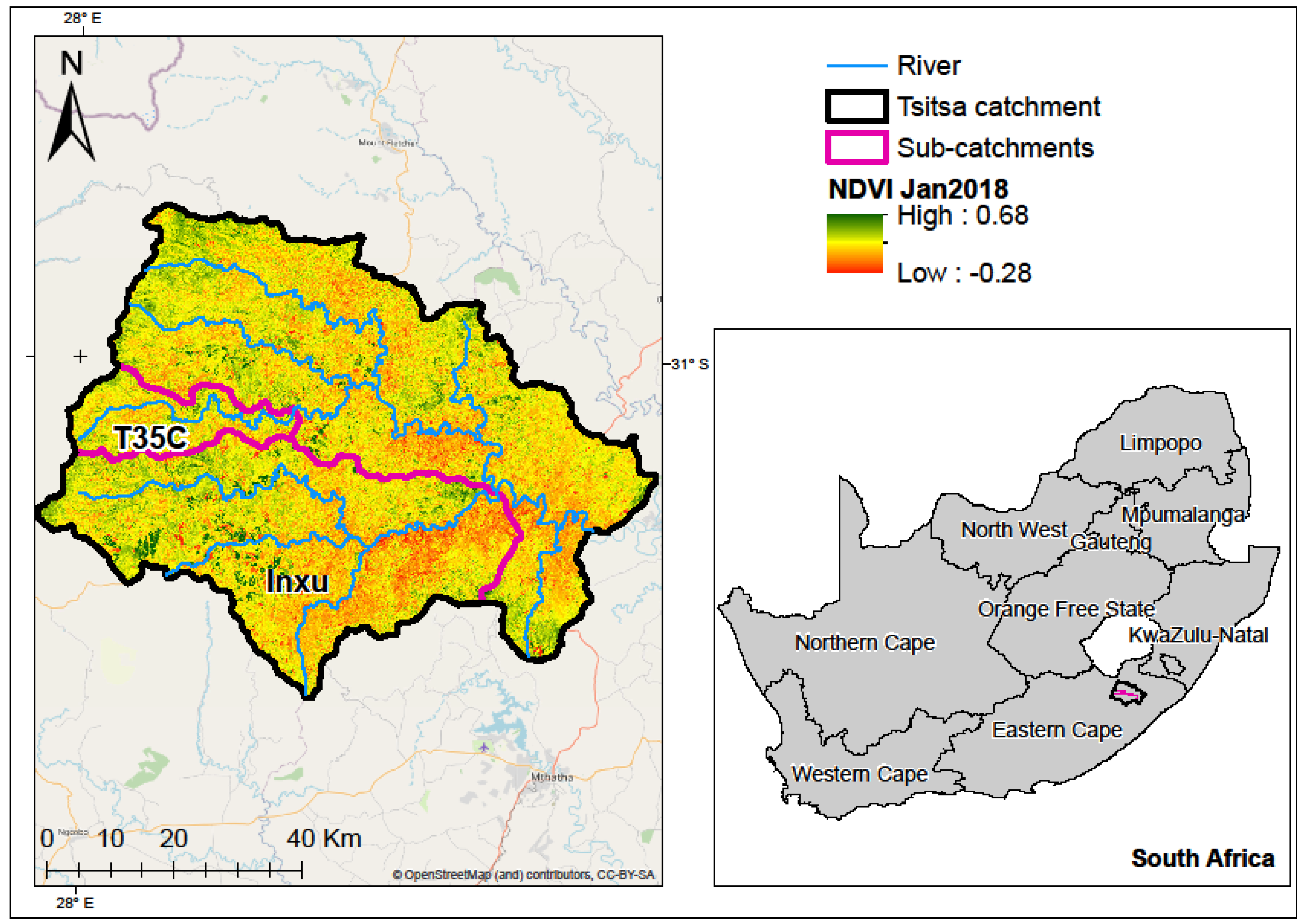
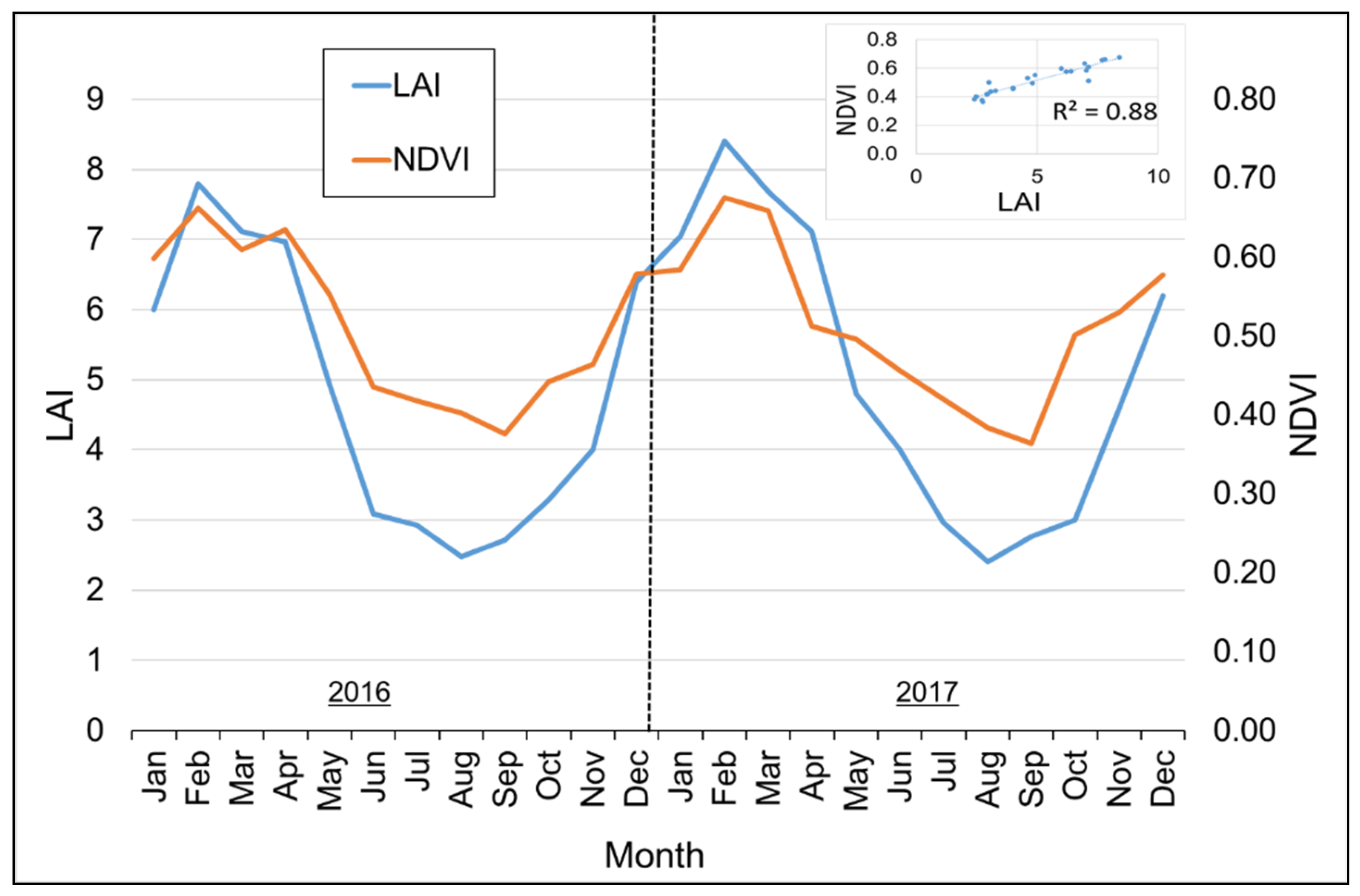
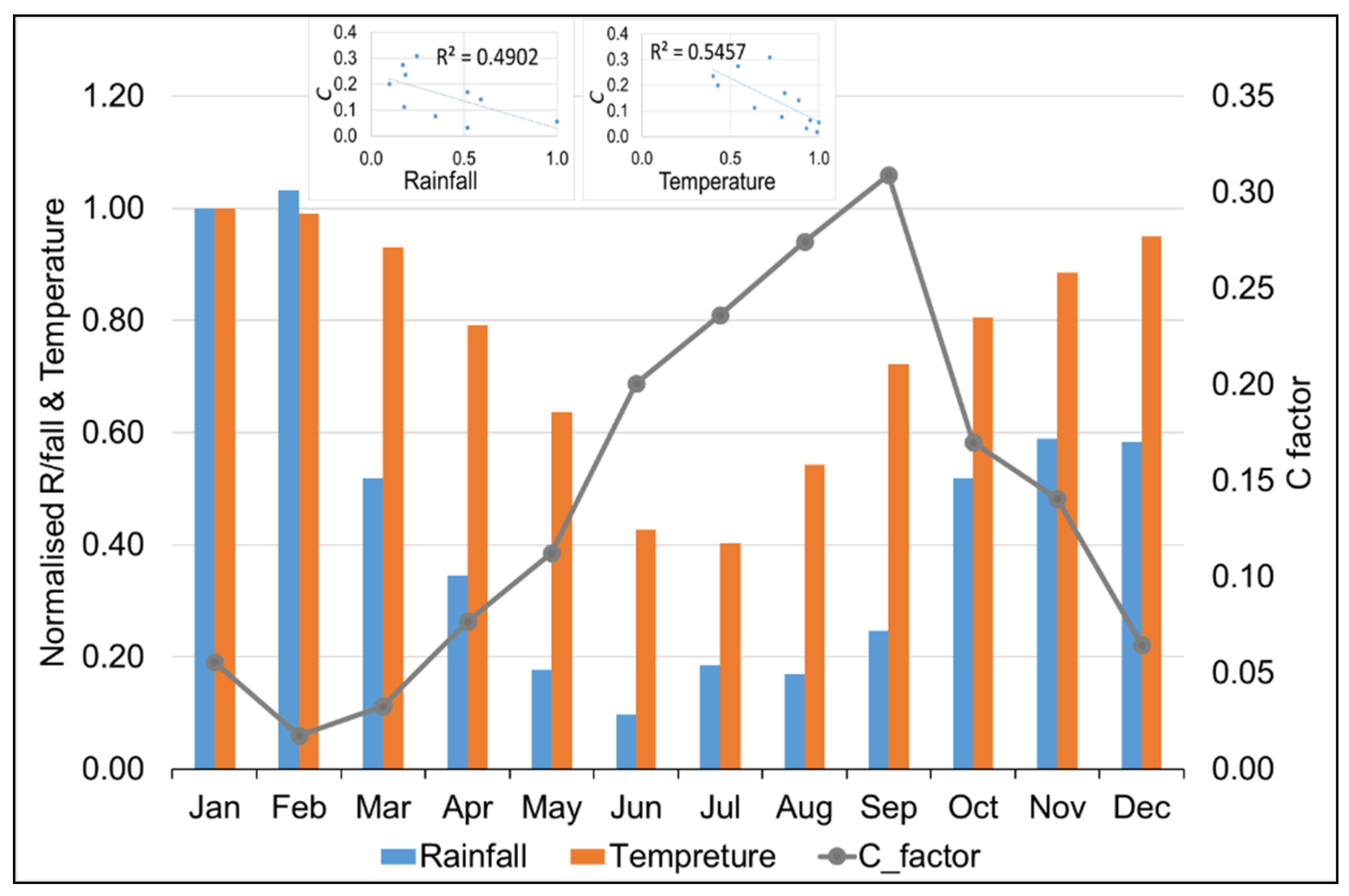
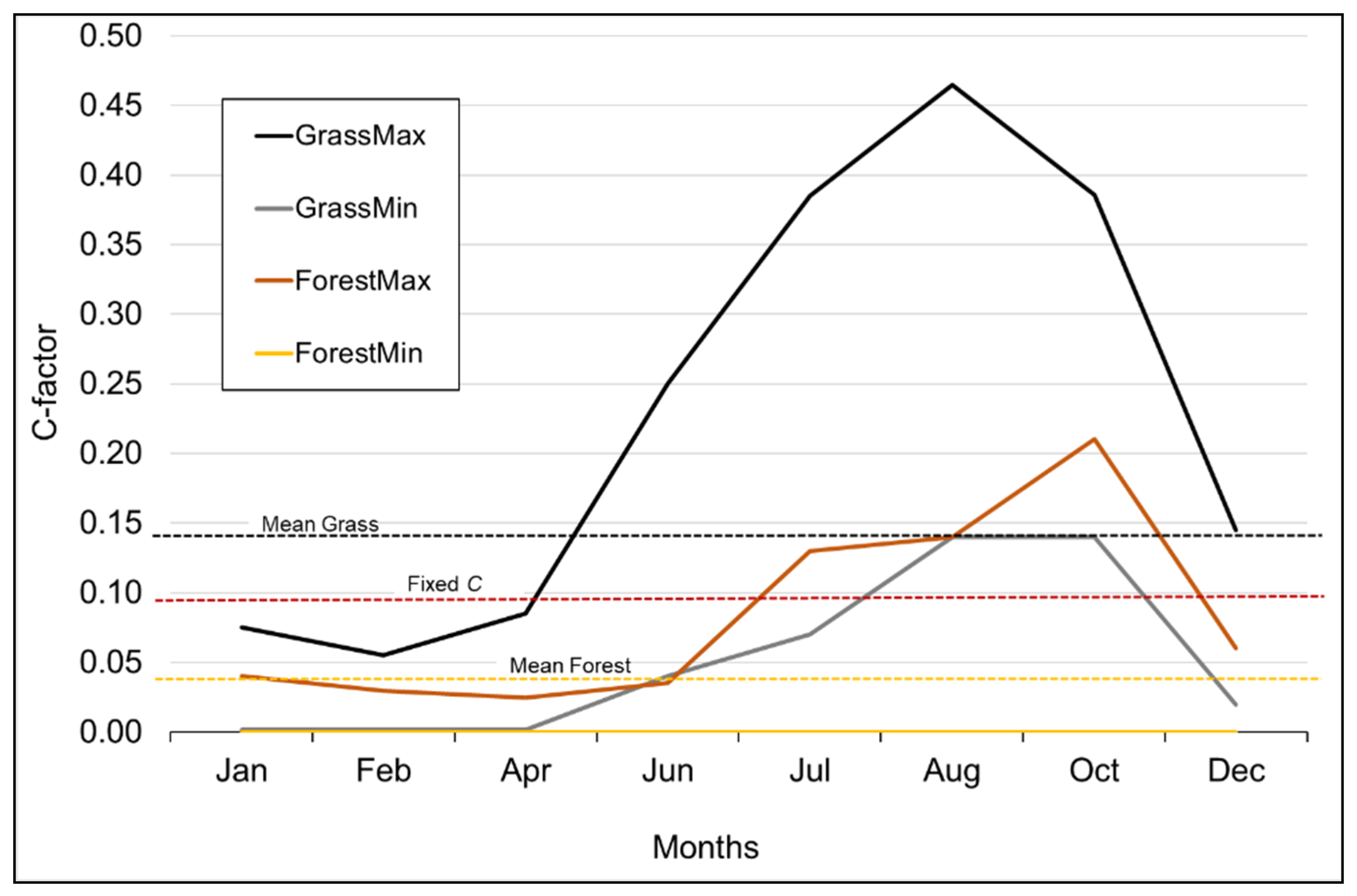
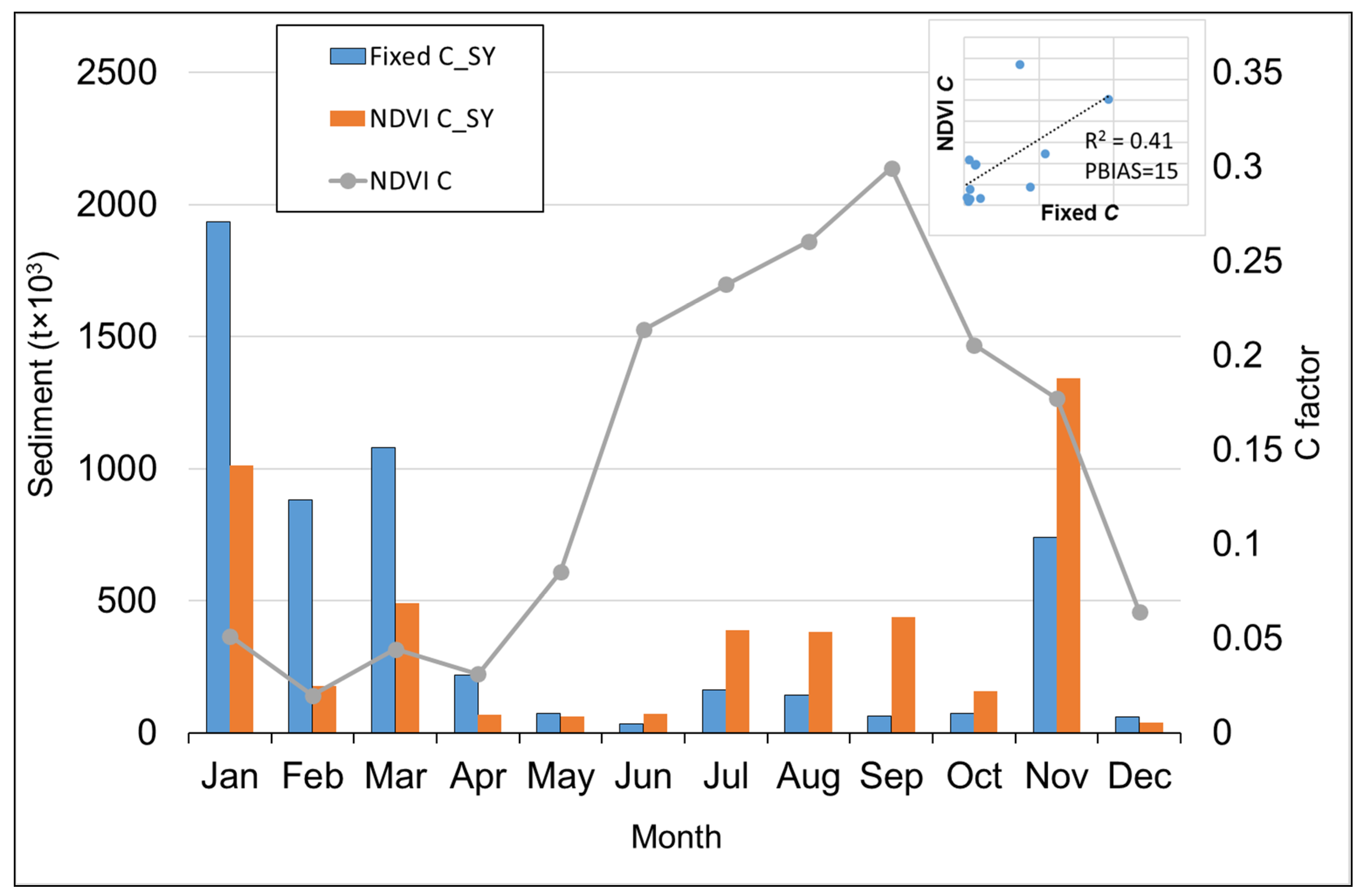
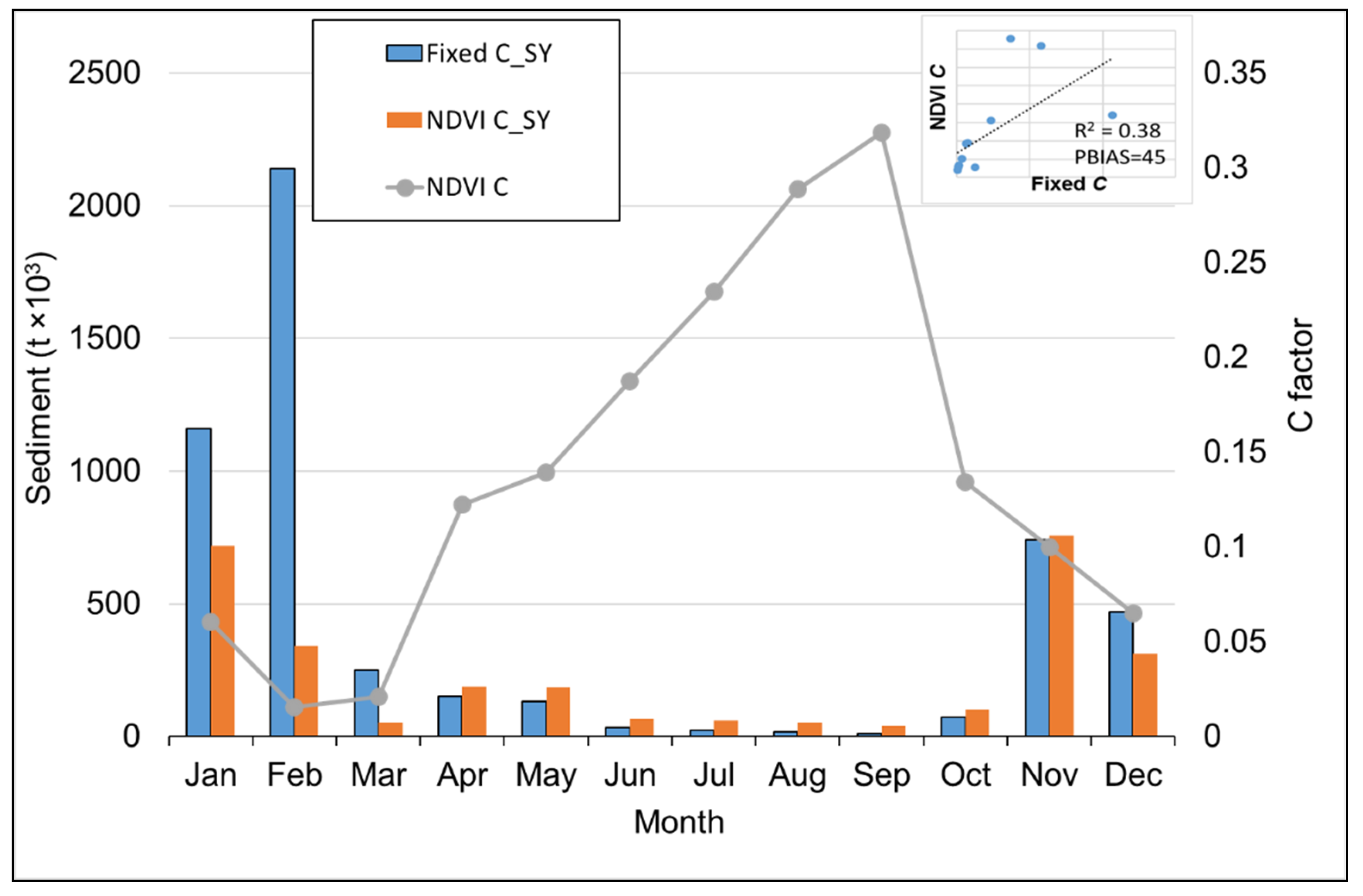
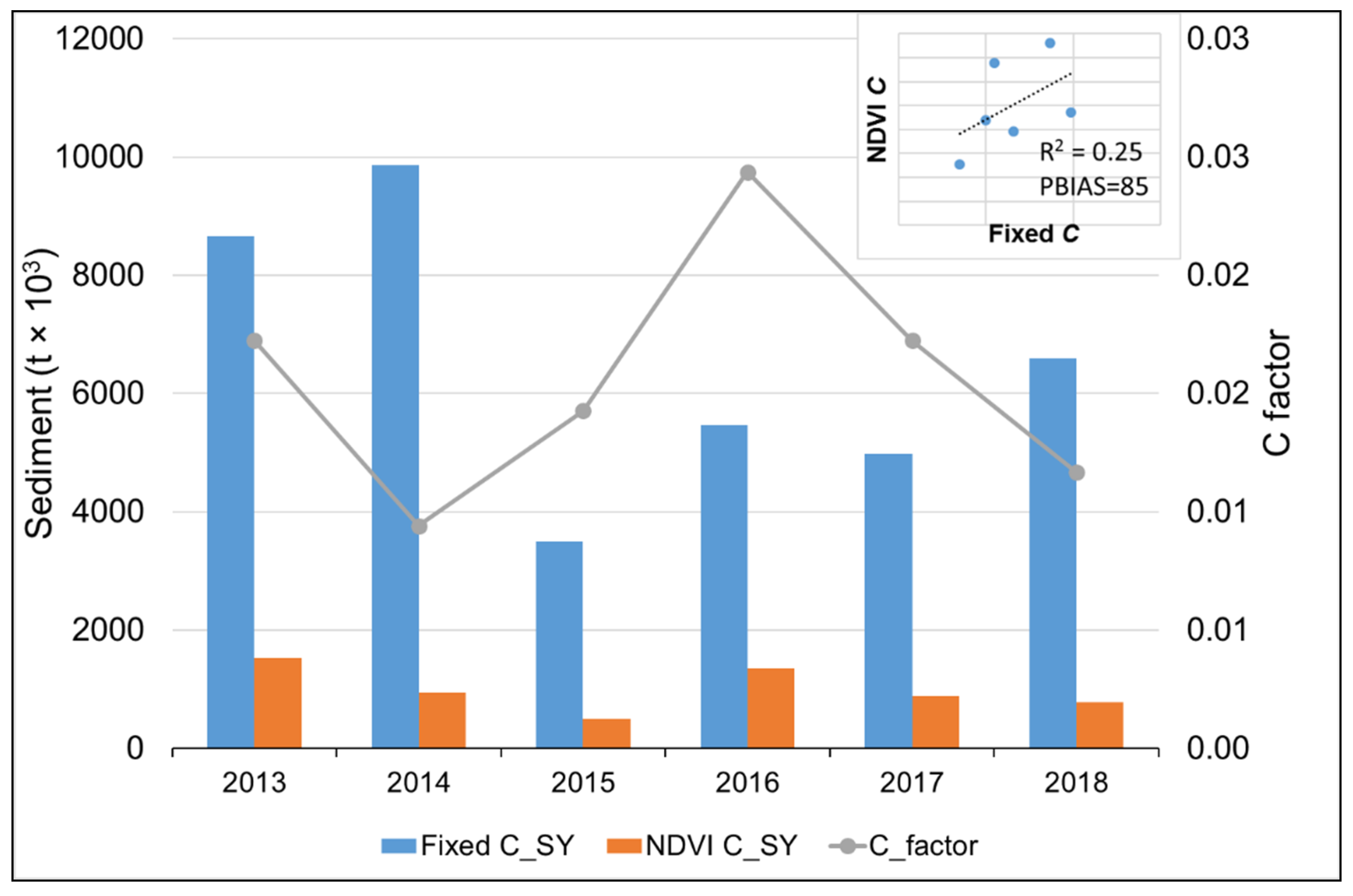
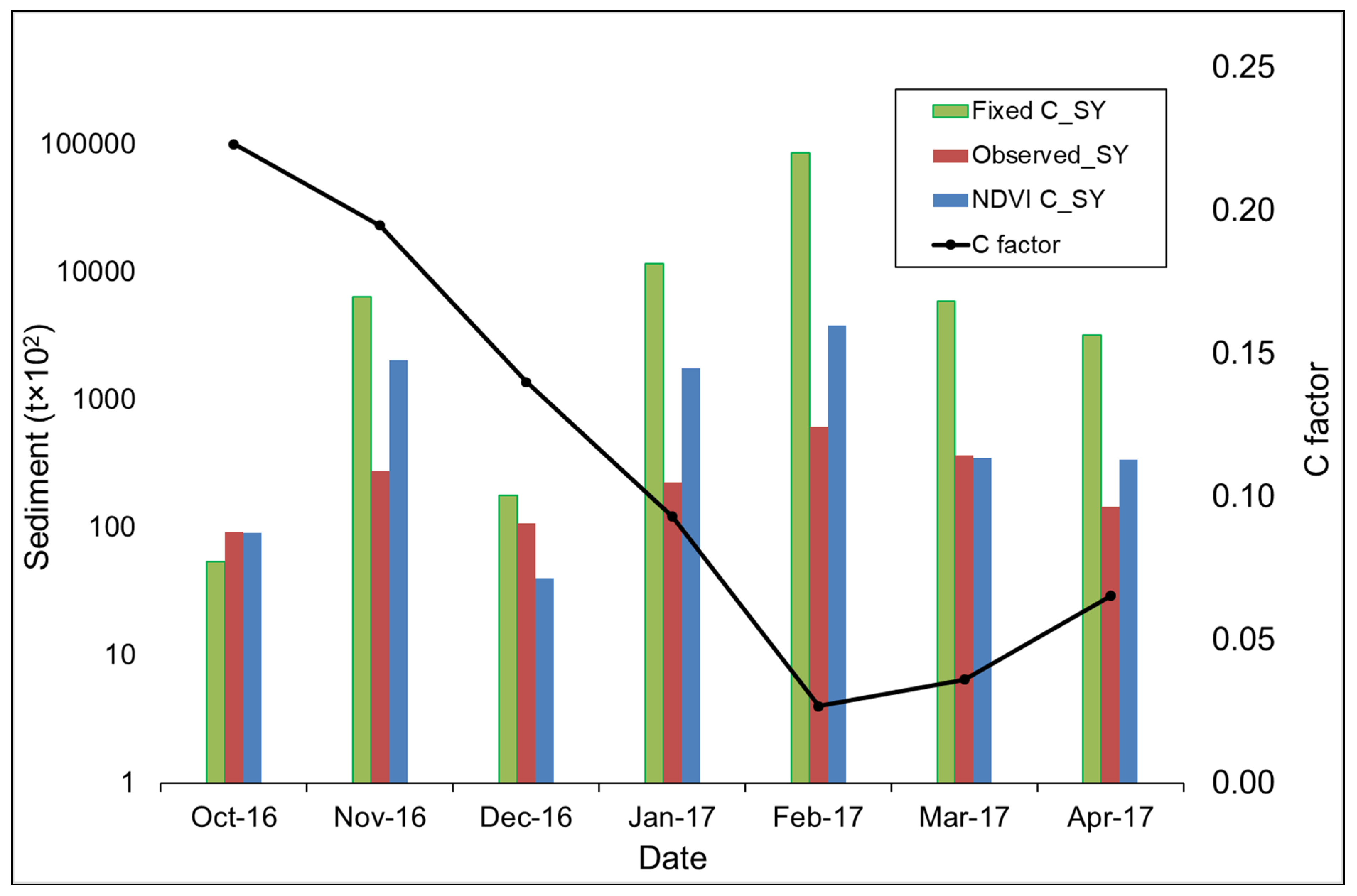
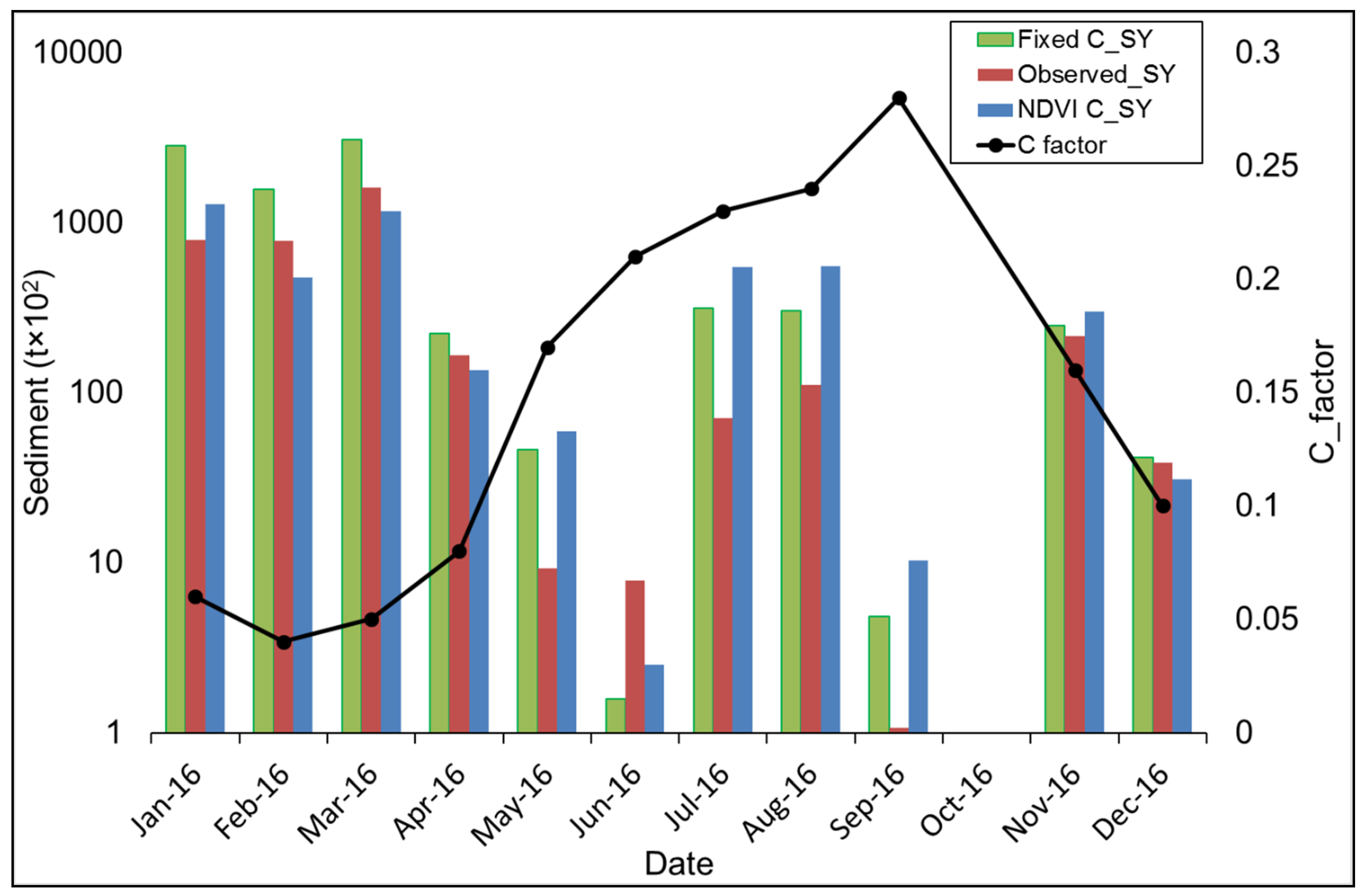
| Year | Acquisition Date |
|---|---|
| 2013 | 28 March |
| 2014 | 14 March |
| 2015 | 8 March |
| 2016 | 19 March |
| 2017 | 18 March |
| 2018 | 9 March |
| Class Name | Pixel Count | % of Total | C Factor | Weighted C Factor |
|---|---|---|---|---|
| Thicket /Forest | 13,441 | 5.1 | 0.009 | 0.000461 |
| Woodland/Open bush | 4234 | 1.6 | 0.012 | 0.000194 |
| Low shrub land | 1306 | 0.5 | 0.013 | 0.000065 |
| Plantations | 38,838 | 14.8 | 0.012 | 0.001776 |
| Cultivated | 3553 | 1.4 | 0.37 | 0.005008 |
| Settlements | 728 | 0.3 | 0.1 | 0.000277 |
| Wetlands | 5897 | 2.2 | 0.038 | 0.000854 |
| Grasslands | 19,4031 | 73.9 | 0.12 | 0.088708 |
| Waterbodies | 31 | 0 | 0.01 | 0.000001 |
| Bare Ground/Degraded | 417 | 0.2 | 1 | 0.000715 |
| Total | 262,476 | 100 | 0.098 |
| Year | NDVI | C Factor | % of Fixed C (0.098) |
|---|---|---|---|
| 2013 | 0.67 | 0.017 | 17 |
| 2014 | 0.70 | 0.009 | 9 |
| 2015 | 0.68 | 0.014 | 14 |
| 2016 | 0.65 | 0.024 | 24 |
| 2017 | 0.67 | 0.017 | 17 |
| 2018 | 0.69 | 0.012 | 12 |
| Catchment | Fixed C Value | Sediment Yield (ton × 103) | SY Relative to Observed | |||
|---|---|---|---|---|---|---|
| Fixed C | Variable C | Observed | Fixed C | Variable C | ||
| Inxu | 0.13 | 11,312 | 840 | 1072 | 10.60 | 0.80 |
| Tsitsa | 0.12 | 785 | 455 | 362 | 2.20 | 1.30 |
| Catchment | C Factor Type | Daily | Monthly | ||||
|---|---|---|---|---|---|---|---|
| R2 | NSE | PBIAS | R2 | NSE | PBIAS | ||
| Inxu | Fixed C | 0.76 | −32 | 954 | 0.99 | −0.81 | 954 |
| Variable C | 0.52 | 0.37 | −21 | 0.67 | 0.49 | −21 | |
| Tsitsa | Fixed C | 0.75 | −0.22 | 115 | 0.89 | −0.92 | 117 |
| Variable C | 0.45 | 0.40 | 22 | 0.65 | 0.62 | 26 | |
Publisher’s Note: MDPI stays neutral with regard to jurisdictional claims in published maps and institutional affiliations. |
© 2021 by the authors. Licensee MDPI, Basel, Switzerland. This article is an open access article distributed under the terms and conditions of the Creative Commons Attribution (CC BY) license (https://creativecommons.org/licenses/by/4.0/).
Share and Cite
Gwapedza, D.; Hughes, D.A.; Slaughter, A.R.; Mantel, S.K. Temporal Influences of Vegetation Cover (C) Dynamism on MUSLE Sediment Yield Estimates: NDVI Evaluation. Water 2021, 13, 2707. https://doi.org/10.3390/w13192707
Gwapedza D, Hughes DA, Slaughter AR, Mantel SK. Temporal Influences of Vegetation Cover (C) Dynamism on MUSLE Sediment Yield Estimates: NDVI Evaluation. Water. 2021; 13(19):2707. https://doi.org/10.3390/w13192707
Chicago/Turabian StyleGwapedza, David, Denis Arthur Hughes, Andrew Robert Slaughter, and Sukhmani Kaur Mantel. 2021. "Temporal Influences of Vegetation Cover (C) Dynamism on MUSLE Sediment Yield Estimates: NDVI Evaluation" Water 13, no. 19: 2707. https://doi.org/10.3390/w13192707
APA StyleGwapedza, D., Hughes, D. A., Slaughter, A. R., & Mantel, S. K. (2021). Temporal Influences of Vegetation Cover (C) Dynamism on MUSLE Sediment Yield Estimates: NDVI Evaluation. Water, 13(19), 2707. https://doi.org/10.3390/w13192707






